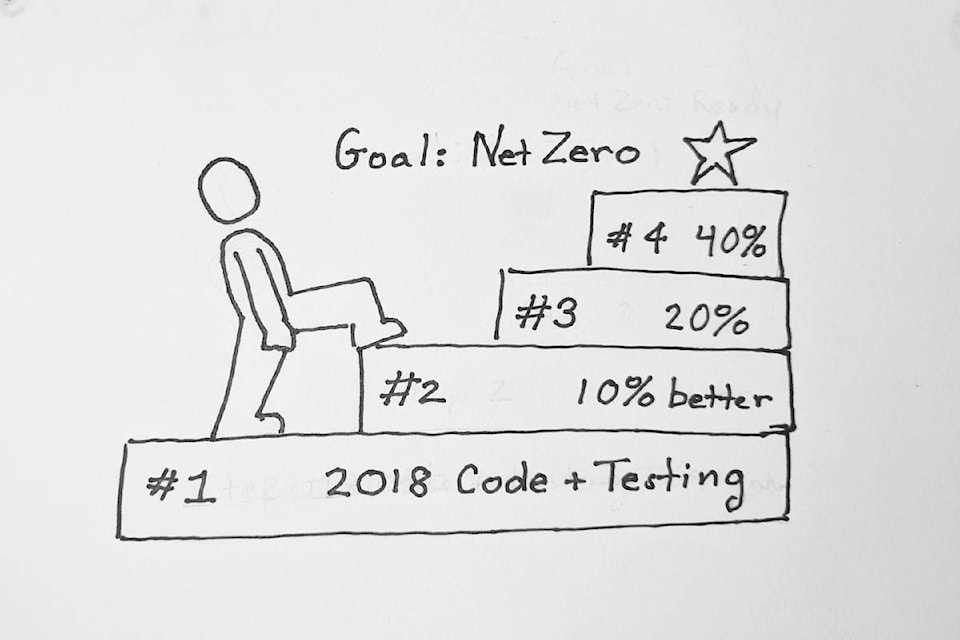One of the most powerful weapons in the fight against climate change also is one of BC’s best kept secrets. Unless you are building a house, you might not have ever heard of the BC Energy Step Code. (Note: the Code covers all kinds of buildings but here I only talk about houses).
In 2015, in and around Vancouver, there were 21 different “authorities having jurisdiction” which were trying to change their local codes with the goal of encouraging energy efficient buildings. This created layers of red tape, different in every location, prompting the construction industry to ask for help from the province. So the province did some research.
READ MORE: B.C. gets top marks in national energy efficiency report card
Making small changes to the BC Building Code every year is a builder’s nightmare. Other places in North America have tried this, without having much effect on how homes are built. So BC asked a very simple question: Where do we want to be in 2032? The answer was:
In 2032 we want all our new homes to be Net Zero Ready
To explain a Net Zero Ready home we first have to talk about energy efficiency. Energy efficiency should be a hot topic. Energy efficiency generates money. Energy efficiency saves the planet. Energy efficiency is cheap and it is even cheaper when it is designed into the building rather than imposed after it is built. Solar electricity is actually a runner-up technology: it is more expensive per kilowatt hour, and unlike insulation it has parts that wear out. So a Net Zero Ready home is one where the house is so energy efficient that the addition of a small solar array could generate all the heat/cooling and electricity that the house needs over the course of the year.
READ MORE: Salmon Arm takes step towards cutting carbon footprint of its buildings
During its research BC discovered that many technologies promised to reduce energy, but when you actually measured the final house, they weren’t living up to their promise. BC decided that the best thing to do wasn’t to pick out technologies, but to define the final goal. “[T]here are no minimum or maximum requirements for insulation, door/window/skylight U-values or equipment efficiency in the BC Energy Step Code” (2019 BC Energy Step Code). Instead there are steps ranging from 10% to 80% measured improvement over where we were in 2018.
Rather than requiring a certain level of insulation, the BC Energy Step Code asks for houses to be tested and to improve on standards from 2018
Contractors are wary of change. The pain can be reduced if they have enough lead time and they know what the change is going to be. Clean BC, working with the BC Energy Step Code, will do three, carefully spaced, changes to the BC Building code. We already know what they are and when they will go into effect. Here are the steps, with the dates they become code:
- Step 1: Follow the energy efficiency requirements in the 2018 building code and work with an energy advisor to model and measure the actual energy efficiency of the new built house. If you and your advisor find inexpensive ways to improve the energy efficiency, so much the better. All the future steps will involve testing and modeling energy efficiency.
- Step 2: 10% more efficient
- Step 3: 20% more efficient [in the BC Building Code in 2022]
The lower steps (1, 2 & 3) can be done with standard building techniques and more careful attention paid to air loss. It’s estimated that lower steps add 2% to the upfront cost of a new building. BC knows that the upper steps will require building performance to go beyond standard practices, and will add substantially more cost to building a home.
- Step 4: 40% more energy efficient [in the BC Building Code for 2027]
- Step 5: Net Zero Ready: 80% more energy efficient than the 2018 Building Code [will be added to the BC Building Code in 2032]
READ MORE: Revelstoke working to adopt BC Energy Step Code
Today 70% of new homes in BC are currently being built to the BC Step Code standards. Cities in the Okanagan that have started BC Step Code consultation with local builders include
Kelowna, West Kelowna, Penticton, Vernon, Peachland, Summerland, Lake Country and Salmon Arm. Kelowna, Penticton and Lake Country have implemented parts of the BC Step Code. RDOS has not participated (Comox Valley Regional District was the first district to do so) though they have considered offering fee rebates for following the Step Code.
Missed the last column?
Kristy Dyer has a background in art and physics and consulted for Silicon Valley clean energy firms before moving (happily!) to sunny Penticton. Comments to Kristy.Dyer+BP@gmail.com
Kristy’s articles are archived at teaspoonenergy.blogspot.com
